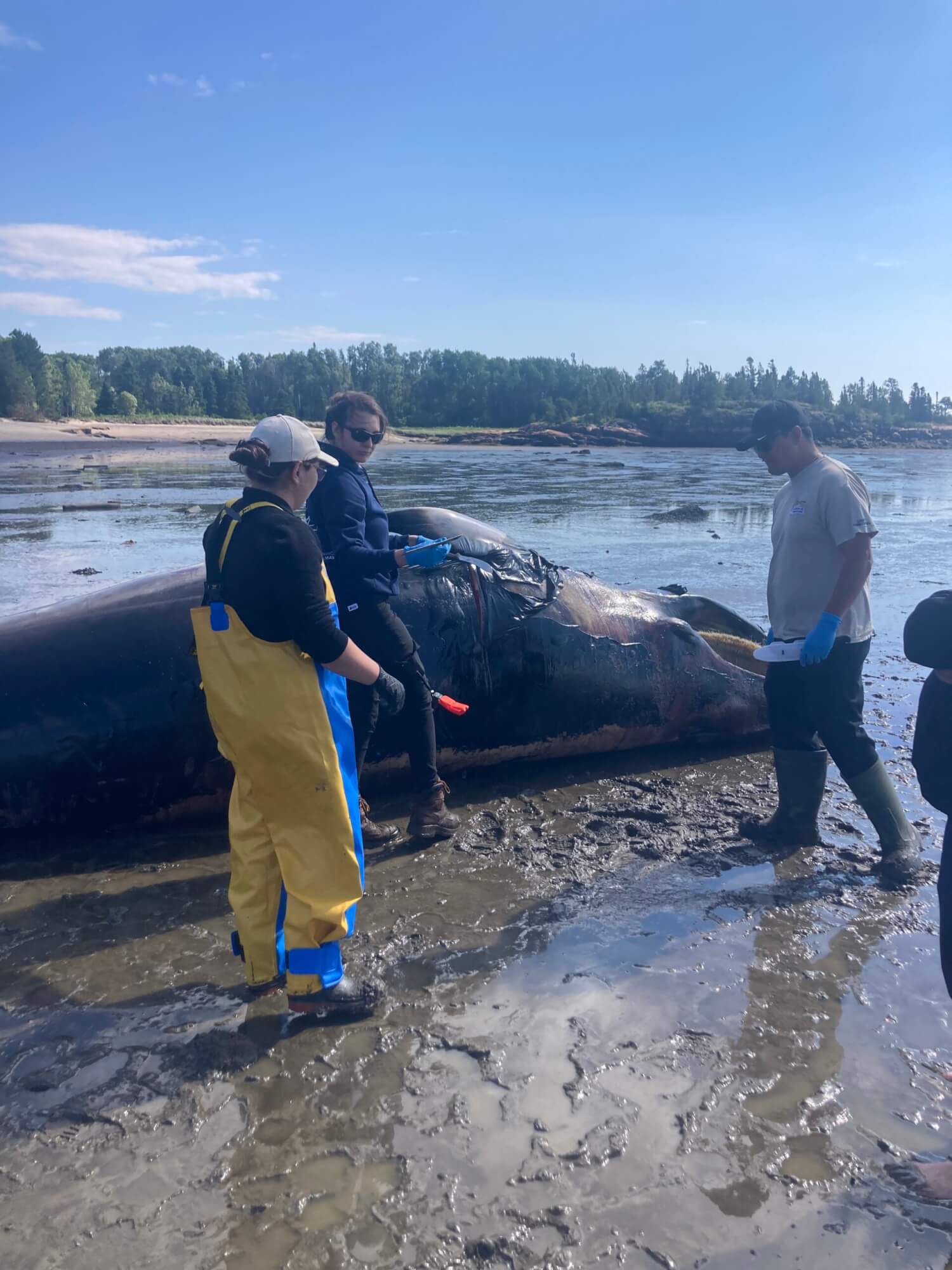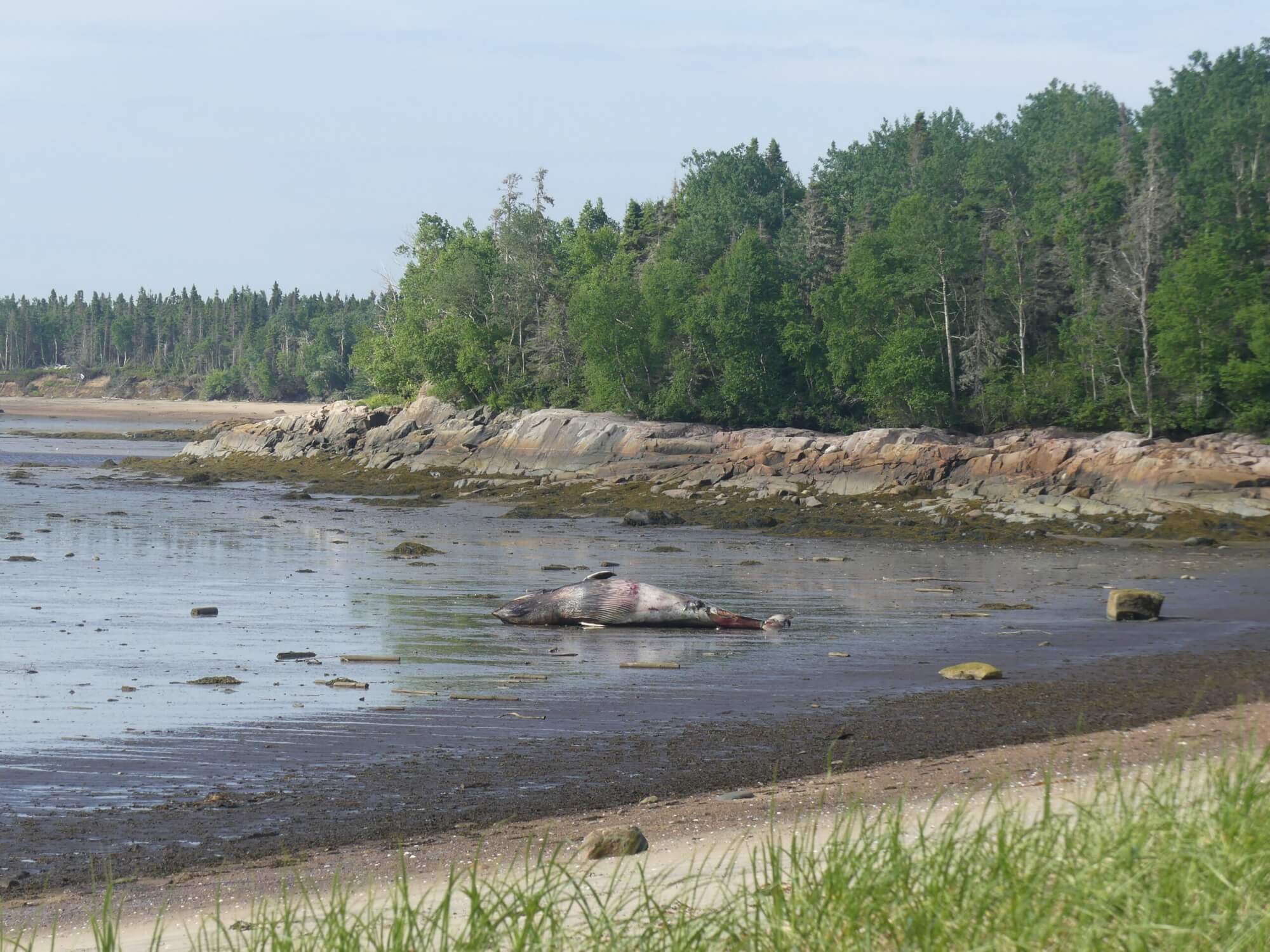I’m riding the ferry between Trois-Pistoles and Les Escoumins when my phone rings. To be honest, I miss the call because it came at the same time a mock rescue was taking place, which had captured my full attention. So it is against a backdrop of cheers and applause as the poor life jacket is “rescued” from the water that I get back to Patrick, head of the Marine Mammal Emergencies (UMM) intervention program. An intervention is planned the following morning to take samples of a stranded minke whale carcass not far from Pessamit in Quebec’s Côte-Nord region. Patrick asks me if might be interesting in participating in the intervention, an opportunity I don’t want to miss!
A morning like no other
Thursday July 4: It’s 5:50 in the morning when I leave for the warehouse with Patrick, where we meet with UMM technician Méduline. Between taking out the protective equipment and getting the sample bags ready, Méduline explains her preparation routine for this type of intervention before the three of us hit the road to locate the minke whale, an hour and 45 minutes away.
This minke whale had first been reported off Ragueneau on June 26 (the previous week). In response to the early evening report, a volunteer from the Quebec Marine Mammal Emergency Response Network (QMMERN) travelled to the site by boat to confirm the species and take photos. As nightfall was approaching and the outgoing tide was already carrying the carcass out to sea, the animal was tagged for identification purposes and to facilitate further reporting. In the course of his intervention, the volunteer was able to document recent entanglement lesions on the animal’s tail.
A few days later, on June 30, a new report of the carcass is received, this time from Papinachois, not far from the community of Pessamit. This is QMMERN’s opportunity to take skin, fat, muscle and baleen samples from this minke whale carcass! These samples represent a gold mine of information for QMMERN’s scientific partners, who conduct analyses to reconstruct the animal’s history to better understand the role and impact that various environmental or human factors are likely to have on marine mammal populations. For minke whales, a species that is not at risk in the St. Lawrence, these samplings make it easier to monitor the population.
Today, we will be joining up with a team from the Pessamit community at the site of the minke whale stranding. These three friendly individuals accompany us on the ground and participate in the intervention.
My mind drifts off during the ride. Would I really be able to tolerate standing near a dead whale? At my previous jobs, I participated in necropsies of farm animals without any issues. Would my attachment to marine mammals make the sight of a beached minke whale unbearable?
Time to visit the minke whale!
We arrive at a breathtaking cove that encapsulates the rugged beauty of the North Shore. In the middle of this scene lies the whale carcass in the distance. The tide is still low, which means there’s no time to waste if we want to take samples! I slip on my overalls and big boots before heading toward the cetacean with our small team.
The wind spares us the stench of the carcass as we get closer to the animal. Méduline wastes no time documenting the carcass and taking photos. The whale’s skin was beginning to peel off, but the entanglement marks on the caudal fin are still clearly visible. Though some people might have found the scene repulsive, my scientific side takes over and I begin to analyze each part of the carcass carefully. How strange it is to see a whole whale, especially in this condition!
Stages of the intervention
Once we finish documenting the carcass, Patrick and I carry out all kinds of measurements of the animal. Total length, length from the eye to the tip of the head, length from the pectoral fin to the caudal fin… every part of the whale is measured! All that remains is to measure the thickness of the blubber, which requires making incisions in the carcass. At the first incision made by Méduline, the carcass releases a strong pressure. She then hands me the knife. The idea of me making a cut on my own feels odd, as if I’m unconsciously afraid of hurting the animal. However, this minke whale has been dead for several days already. With this in mind, I get down to work.
At last, we reach the final stage of the intervention: sampling. I have the knife in my hand again, this time to sample part of the blubber layer. No easy task, as the knife quickly becomes dull from cutting through all the blubber. To get a better grip, I find myself having to lean on the carcass, which is dripping with fat. It is at this moment that I realize that, even if I’m wearing my personal protective equipment, I haven’t yet dared to directly touch the whale since the start of the task. It is not out of disgust or fear of getting dirty, but quite simply that it is inconceivable to me that I’m standing so close to one of these giants of the seas, a 7-metre-long minke whale!
Once the sampling is complete, it’s time to head home. Taking one last glance, I can see that the tide has almost reached the carcass. In a few days from now, the Ministry of the Environment, the Fight against Climate Change, Wildlife and Parks (MELCCFP) will remove the minke whale from the site, as the proximity of the carcass to a local dwelling makes it a health risk. Under different circumstances, the carcass might have been left to the whims of the tides and ultimately become beneficial to marine life once it reaches the bottom of the sea…
What a unique experience!









